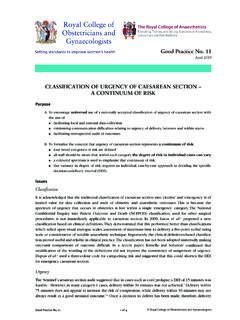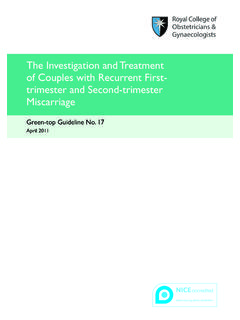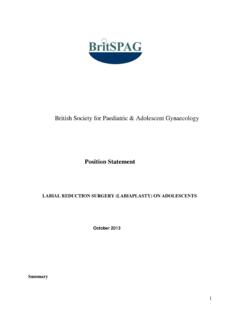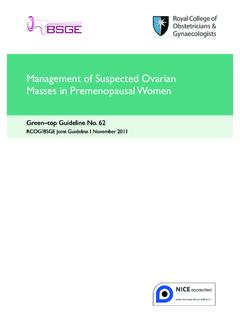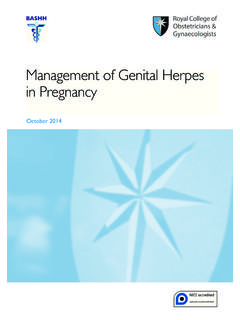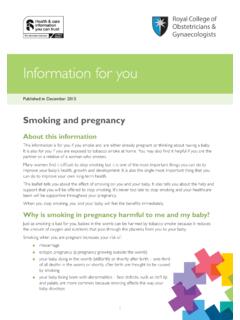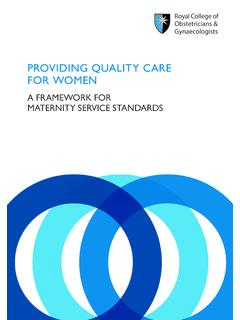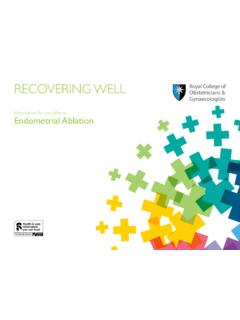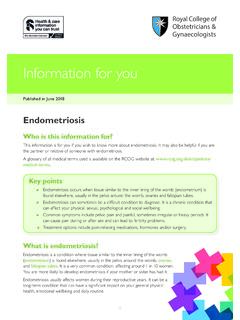Transcription of Reducing the Risk of Venous Thromboembolism during ...
1 Reducing the Risk of Venous Thromboembolism during Pregnancy and the Puerperium Green-top Guideline No. 37a April 2015. Reducing the Risk of Venous Thromboembolism during Pregnancy and the Puerperium This is the third edition of this guideline, first published in 2004 under the title Thromboprophylaxis during Pregnancy, Labour and after Vaginal Delivery' and revised in 2009 under the title Reducing the Risk of Thrombosis and Embolism during Pregnancy and the Puerperium'. Executive summary of recommendations Prepregnancy and antenatal risk assessment What are the risk factors for Venous Thromboembolism (VTE) in pregnancy and the puerperium and what is the magnitude of risk for these factors?
2 All women should undergo a documented assessment of risk factors for VTE in early pregnancy or prepregnancy. C. Risk assessment should be repeated if the woman is admitted to hospital for any reason or develops other intercurrent problems. C. Risk assessment should be repeated again intrapartum or immediately postpartum. C. Any woman with four or more current risk factors shown in Appendix I and Table 1 (other than previous VTE or thrombophilia) should be considered for prophylactic low-molecular-weight D.
3 Heparin (LMWH) throughout the antenatal period and will usually require prophylactic LMWH for 6. weeks postnatally but a postnatal risk reassessment should be made. [New 2015]. Any woman with three current risk factors shown in Appendix I and Table 1 (other than previous VTE or thrombophilia) should be considered for prophylactic LMWH from 28 weeks and will D. usually require prophylactic LMWH for 6 weeks postnatally but a postnatal risk reassessment should be made. [New 2015]. Any woman with two current risk factors shown in Appendix I and Table 1 (other than previous VTE.)
4 Or thrombophilia) should be considered for prophylactic LMWH for at least 10 days postpartum. D. [New 2015]. Women admitted to hospital when pregnant (including to the gynaecology ward with hyperemesis D. gravidarum or ovarian hyperstimulation syndrome) should usually be offered thromboprophylaxis with LMWH unless there is a specific contraindication such as risk of labour or active bleeding. [New 2015]. The risk of VTE should be discussed with women at risk and the reasons for individual recommendations explained.
5 [New 2015] P. Previous VTE. How should women with previous VTE be managed in pregnancy? (see Appendix IV). Single previous VTE. Women with previous VTE should be offered prepregnancy counselling and a prospective management plan for thromboprophylaxis in pregnancy made. Those who become pregnant before P. receiving such counselling should be referred at the earliest opportunity in pregnancy to a clinician with expertise in thrombosis in pregnancy. RCOG Green-top Guideline No. 37a 2 of 40 Royal College of Obstetricians and Gynaecologists Women with previous VTE (except those with a single previous VTE related to major surgery and no other risk factors) should be offered thromboprophylaxis with LMWH throughout the C.
6 Antenatal period. [New 2015]. Women with previous VTE should have a careful history documented. Where objective C. documentation is not available, the previous diagnosis of VTE can be assumed in cases where the woman gives a good history and received prolonged (greater than 6 weeks) therapeutic anticoagulation. [New 2015]. Thrombophilia-associated VTE. Heritable thrombophilia Women with previous VTE associated with antithrombin deficiency (who will often be on long-term oral anticoagulation) should be offered thromboprophylaxis with higher dose LMWH (either 50%, D.)
7 75% or full treatment dose) (see Appendix IV) antenatally and for 6 weeks postpartum or until returned to oral anticoagulant therapy after delivery. Management should be undertaken in collaboration with a haematologist with expertise in thrombosis in pregnancy and consideration given to antenatal anti-Xa monitoring and the potential P. for antithrombin replacement at initiation of labour or prior to caesarean section. [New 2015]. If anti-Xa levels are measured, a test that does not use exogenous antithrombin should be used and 4-hour peak levels of iu/ml aimed for.
8 [New 2015] P. Other heritable thrombophilic defects are lower risk and can be managed with standard doses of thromboprophylaxis. [New 2015] P. Acquired thrombophilia see also section Women with VTE associated with the antiphospholipid syndrome (APS) (who will often be on long- term oral anticoagulation) should be offered thromboprophylaxis with higher dose LMWH (either D. 50%, 75% or full treatment dose) (see Appendix IV) antenatally and for 6 weeks postpartum or until returned to oral anticoagulant therapy after delivery.
9 [New 2015]. Pregnant women with APS and prior VTE or arterial thromboses should be managed in collaboration with a haematologist and/or rheumatologist with expertise in this area. [New 2015] P. Previous recurrent VTE. What extra advice is needed for women with previous recurrent VTE? Advice regarding doses of LMWH in pregnancy should be sought from a clinician with expertise in haemostasis and pregnancy. [New 2015] P. Some women with previous recurrent VTE require higher doses of LMWH. [New 2015].
10 P. Women on long-term warfarin or other oral anticoagulants should be counselled about the risks of these agents to the fetus (see section ) and advised to stop their oral anticoagulant therapy and P. change to LMWH as soon as pregnancy is confirmed, ideally within 2 weeks of the missed period and before the sixth week of pregnancy. [New 2015]. Women not on warfarin or other oral anticoagulants should be advised to start LMWH as soon as they have a positive pregnancy test. [New 2015] P. RCOG Green-top Guideline No.
